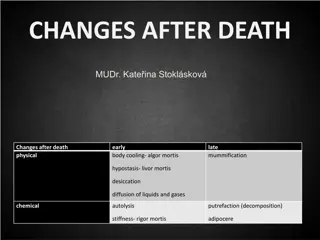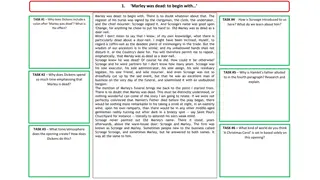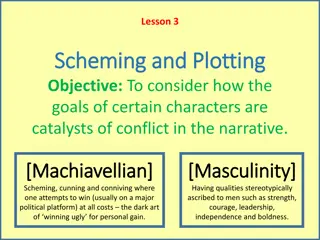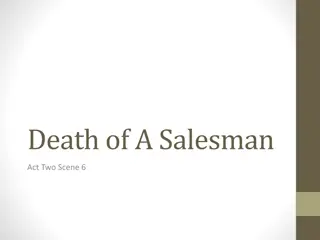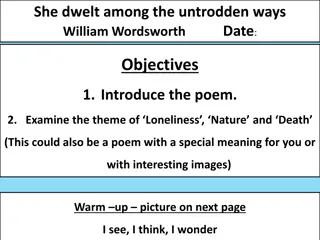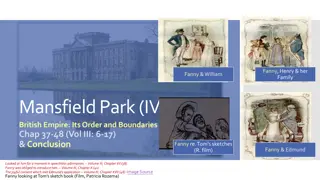Analysis of "Death of a Salesman" Character Dynamics and Themes
Set in post-WWII America, "Death of a Salesman" explores the inner turmoil and tragic fate of Willy Loman, a character trapped between the American dream and societal injustices. Willy's delusions and conflicting desires drive him to suicide, reflecting the impact of capitalism on familial relationships and personal identity. The play vividly portrays Willy's mental deterioration and his struggle to reconcile his dreams with reality, ultimately leading to a poignant exploration of disillusionment and self-deception.
Download Presentation

Please find below an Image/Link to download the presentation.
The content on the website is provided AS IS for your information and personal use only. It may not be sold, licensed, or shared on other websites without obtaining consent from the author.If you encounter any issues during the download, it is possible that the publisher has removed the file from their server.
You are allowed to download the files provided on this website for personal or commercial use, subject to the condition that they are used lawfully. All files are the property of their respective owners.
The content on the website is provided AS IS for your information and personal use only. It may not be sold, licensed, or shared on other websites without obtaining consent from the author.
E N D
Presentation Transcript
The play is set in 1949, a time when many Americans, after the great depression, felt rescued by the industrial boom of WWII and felt economic prosperity in reach. This coupled with the American dream that indirectly invites self-centeredness and social injustice forms the mental make up of the protagonist of the play, Willy Loman. He is a failed but deluded middle class American who is trapped between the American desire to be successful and the unjust social setup that thwart these desires. Hence arises an inner turmoil in Willy that leads to his ultimate suicide. The conflicting inner selves that make up Willy Loman s many-sided persona represent his experience of the outer world refracted through the distorting medium of his fantasies. As the action of the play progresses, the connections between Willy s inner world and external reality, which are tenuous enough to begin with, grow increasingly unstable and volatile. He is driven to kill himself, the ultimate act of self- deception in his struggle to impose his fantasies upon a reality that consistently thwarts his ambitions and will.
It is Willy Lomans dreams that inform his character as well as those around him. He being charmed with anticipated success and cult personality begins to loose touch with reality. The play fluctuates between 1942 in the present to 1928 in the past and is told primarily through memories. Not only is Willy Loman the chief character but it is primarily from his inner perspective that the play s dramatic action derives its meaning. The actual events enacted in his presence, particularly the return of his son Biff, become the trigger for Willy s recollections and fantasies which constitute the play s imaginary sequences. The significance of each of the play s episodes, as well as the structure of the plot as a whole, depends on the rhythmic alternations between actuality and Willy s mental responses to them. His ideal self-image and the reality of his actual behaviour and circumstances are the poles of both his inner existence and his dramatic interactions with the other characters.
Driven by a capitalist ideology the characters in the play are caught in a ruthless market world in which emotions and feelings lead to dysfunction within family. The play represents a family caught up in a lot of unresolved conflicts, the most important of being the one embodied in the relationship of Willy and Biff. Willy and Biff form a symbiotic relationship. Biff cannot gain freedom from his father s imperative until his father somehow frees him from it as, tragically speaking, he can do only through death. Similarly, Willy cannot succeed until he can align his love for Biff with the dream he follows
The play traces Willys mental deterioration in all its painful stages and looks for its causes. The conduct of the play s other characters is in great measure both the effect of Willy s illusory perception of external reality and the cause of his deepening submersion into the world of his fantasies. When reality becomes too painful, Willy retreats into a dream world, consisting of his roseate recollections of the past and of fantasies in which he fulfils the aspirations, the attainment of which has eluded him in life. Although his memories are based on actual events, these are falsified in his mind by wishful thinking about how they ought to have turned out. Hence in Willy s mind, reality as it is immediately experienced by him merges in his consciousness with his recollection of distant events to form a seamless continuum of past and present time. The same is true of the many symbols used in the play like rubber pipe, flute (expressionist device for life in the open, of hope), silk stockings (sexual infidelity), seeds (ambition), diamond (success and wealth) woods (symbol of life and strength), tape recorder (commodity ridden culture). These symbols too are representative of Willy s mental reality rather
Some of Willys memories are about his father and brother. Willy s father never assumes substantial form in his mind but nonetheless powerfully informs his fantasy, primarily through his imagined conversations with Ben. Willy s father, the least accessible and most dimly remembered of all, can be called to function as his absolute ego ideal. His brother, Ben, with whose adventurous life and grand mercantile enterprises in the forest Willy compares his own used up life can be said to his desiderative ego ideal. Another important person who has inspired Willy and shaped his idea of success is Dave Singleman, the quintessential salesman that embodies glamour, wealth and respect. He can be called Willy s attainable ego ideal.
The play is structed like Willys mind and what goes on in it. Even the set is laid out in a manner where the present and the past can seamlessly merge into one another. The dramatic rhythm of Death of a Salesman, as manifested in the development of character, takes place through a complex interplay on the function of dramatis personae and their interplay with the three levels of Willy s consciousness: first, on the level of ideality; second on the level of fantasies and dreams; and last, on the level of his perception of concrete reality. It is from these three levels of consciousness that the protagonist s three ego ideals, the absolute, the desiderative, and the attainable, emerge. Taken as a whole, Willy s three levels of consciousness dramatize his attitude to himself, to the others and to social reality.
The language in the play despite being seemingly simple has important functions to play. To achieve the depths of tragedy, Miller expands the ordinarily limited expressive capabilities of demotic English by exploiting the sounds and multiple meanings of simple verbal, visual, and numerical images. Words for ordinary objects, daily activities, geographical places, and conventional relationships also function as puns and homonyms which recall meanings from other contexts and establish new ones. The resulting verbal patterns and images form an interconnected and multileveled network of associated meanings which exist in two temporal perspectives: chronological time and construct in which meaning echo and mirror each other, creating nightmarish repetition and a sense of stasis.
Despite being deeply flawed it is hard to remain unsympathetic to Willy s character. He has his fault but he is a redeemable character by any means. Even if Willy fails to make the right moral choices (though no choice can be right in relation to the contending poles in the dialectic), he is surely not amoral. The play demands an accounting for his actions. One may contend that Willy lacks intellectual awareness, of course, and is thereby diminished as a tragic hero, but not that he is morally moribund. Few characters in modern drama expose so vividly the presence of a guilty conscience.
Willy Lomans tragedy is thoroughly modern for it shows his struggle against forces that are primarily material. Willy might be considered a composite tragic hero in that his divided nature and tragic fate are inexplicably bound to his two sons, who represent the poles in the dialectic. Willy s choice to follow the dictates of the cultural ethos most directly affects his family, which provides the locus of the tragic action. The larger community and its unifying myth of universal order are projected in the altar, the palace, and the throne-room in traditional tragedy; but the fragile Loman house, part externally real and part psychically real, houses a fragmented, dysfunctional family, where Willy s adherence to the law of success makes him, as Dan Vogel has noted, a petty tyrannos in his own house. But whereas the family was subsumed by community, by public and even metaphysical-religious repercussions in Greek drama, William Demastes has reminded us, in the Loman household family matters are disconnected from the larger human society or a spiritually charged cosmos.






